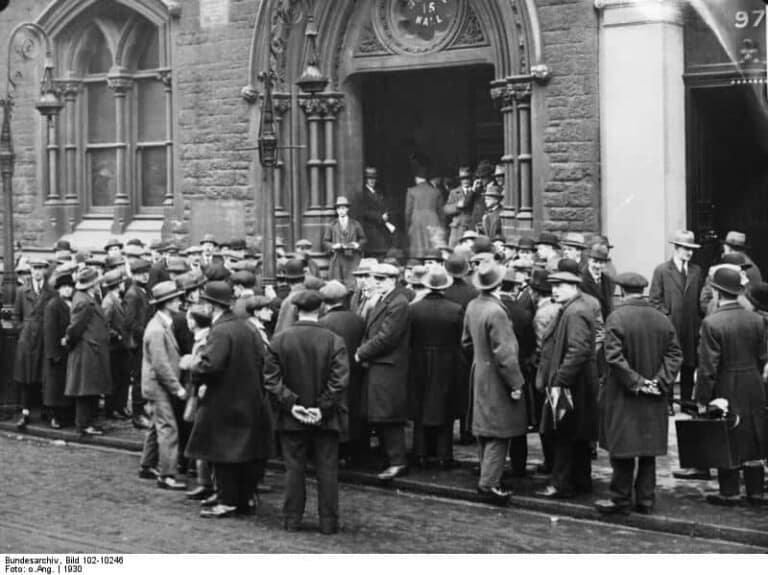The work of Charles Booth and Rowntree (see Chapter 2: Victorian Philanthropy) influenced a new current within the Liberal Party: new Liberalism.
When the Liberal Party was returned to office in 1906, supported by the nascent Labour Party, it introduced several important pieces of legislation: Education (Provisions of Meals) Act (1906), Education (Administrative Provisions) Act (1907), Children Act (1908), Old Age Pensions Act (1908), Trade Boards Act (1909), Labour Exchanges Act (1909) and Health and Unemployment Act (1911).
Even if we take all these laws together, we only have a piecemeal attempt to deal with social protection. Lloyd George and Churchill (at the time a Liberal) were responsible for the 1911 legislation on unemployment insurance and believed that something should be done to improve a situation that had scarcely evolved since 1834.
The liberals were not overtly committed to social reform during the 1906 election campaign but espousing such a cause was a way of possibly stymying the nascent Labour Party and also preventing any more revolutionary attempts at changing the social system.
Not all workers were covered by this legislation. Only wage-earners were eligible and sexually transmitted and alcohol-related diseases were excluded.
Of course, the wives and children of the poor and the unemployed were also excluded. The Act was administered essentially by the former (private) insurance companies, which became richer, as did the “panel doctors”, guaranteed a per capita sum per “panel patient”.
Even the extension of the Act in 1920 only brought under its umbrella 75% of the workforce. Another strand connected to a desire for improvement in social conditions was the wish to improve the health of many of the urban poor.
After all, Britain depended on its military strength, which in turn depended on the fitness of its men. A weakened working class would be unable to defend Britain’s interests in times of international conflict.
The inter-war years (1918-1939) were characterised by a great paradox: economic instability and recession in much of the country and also a rise in the standard of living for the majority of the population.
In 1918, Britain was still a strong economic and industrial power (especially in the fields of cotton, coal, shipping and international trade in general). The First World War forced the Government to switch the emphasis to armaments, which when peace came had a distorting effect on economic activity.
The cost of the war was high: Britain changed from being a creditor nation to a debtor nation. As an island trading nation, Britain was particularly affected by the changes in the international trading system.
The inter-war years were characterised by wild swings, oscillations from free trade to protectionism, and great uncertainties, all of which affected Britain.
After World War I, Britain’s entrepreneurial class showed great reluctance to move into new industries, such as electricity, artificial fibres, cars, luxury items, new foods…
In 1907, the new industries accounted for 6.5% of Britain’s total industrial output; in 1928, the figure had only reached 16.3%. The rise in the importance of the new industries was modest but still there for all that.
In the old industries, the example of the Lancashire textile industry is exemplary: a desire to go back to the old 19th-century ways, even though the machinery was now written off and a reluctance to amalgamate and thus, for mill owners, the fear of losing their independence.
Governments in the 1920s followed orthodox policies. In 1920, the Bank Rate was raised to 7%, hence encouraging saving and discouraging spending. In 1921, the Geddes’ Economy Committee was set up and reduced public expenditure.
In 1925, Churchill, the Chancellor of the Exchequer, reintroduced the Gold Standard, which re-established pre-World War I parity of the Pound and the Dollar. In so doing he did not take into account the fall in the Pound that had taken place in the intervening years. This produced a handicap for the British industry, overvaluing the British currency (£1 = $4.25).
According to orthodox economic principles, costs had to be cut and often wages suffered. It remained at 2% until 1939. Britain, France and the USA signed a tripartite agreement to stabilise currencies but throughout the 1930s, the level of the Pound remained too high to really kick-start the economy. The great battle was between free trade and protectionism.
The first few hesitant steps were taken in 1932 with the Import Duties Bill which introduced 10% tariffs on all imported goods from non-Empire countries, pending a world agreement on international trade. Prime Minister Baldwin talked of “safeguarding”.
There were several changes in the population during the inter-war years. There was a rise in the proportion in the population of working-age leading to a rise in the number of producers as compared with consumers. This led to a rise in national output, despite the high unemployment of the early 1930s.
There was a shift in the population from the industrial North and South Wales to the South, the Midlands, and the South-East. The population of Greater London increased from 7.5m in 1921 to 8.5m in 1939, whereas the population of South Wales fell by 100,000 between 1931 and 1938.
There was an increase in the population of new towns (Coventry, Luton, Slough…). In the 1930s, there were also net inflows into the country. Some former emigrants returned to Britain and there were inflows from Ireland and refugees from Europe.
Between 1931 and 1941, there was an increase in the population of 650,000. Nevertheless, there was a slowdown in indigenous population growth due to the deaths of so many males during the War, the phenomenon of increased wealth and more birth control.
There were also changes in the economic and social status of women: in 1911, 5.75m women were in employment; in 1936, the figure had risen to 6.5m. Changes in patterns of female behaviour (including going out to the pub !) were linked in part to a certain emancipation after female suffrage had been obtained in 1918 and 1928 (see More electoral inequalities : the Road to Female Suffrage)
As far as social class was concerned, Britain was still a class-conscious society but changes were taking place: there was a move away from the landed aristocracy towards a prosperous business class. The middle class developed with the increase of salaried office workers.
There was an increase in the professions, and civil servants and a gradual rise in the number of female members of the working middle class. At the same time, there was a decrease in servant employment. In 1936, the Government defined “working class” as follows:
The expression “working class” includes mechanics, artisans, labourers and others working for wages, hawkers, costermongers, persons not working for wages but working at some trade of handicraft without employing others, except members of their own family, and persons other than domestic servants whose income in any case does not exceed an average of £3 a week, and the families of such persons who may be residing with them.
Schedule II, The Housing Act, 1936
A divided country
The country was very much divided during the inter-war years between the old 19th century “half”, where wages fell during the Depression, and the new “half” (in the Home Counties for instance) where wages actually increased during that period.
The Hunger Marches were an attempt to show the other half of the country what the North-East was going through. National unemployment reached a peak of 3m in January 1933 and then fell back to 1.6% (i.e. 12% of the insured population) where it remained until 1939.
Many observers point to an absence of real resentment against class inequality. Trying to explain this, Runciman (in Relative Deprivation and Social Justice, 1966) advances the theory of relative deprivation: satisfaction or resentment are not functions of inequality as measured by economists but by man’s assessment of his own position compared to others with whom he compares himself.
Between World War I and the 1960’s, working men compared their lot with that of others in the working class and not with non-manual groups. Also, it has been pointed out that unemployment did not lead to the break-up of the family, despite the great pressures on the role of the male as”bread-winner”, and the difficulties often felt by women in trying to eke out a living.
There was rarely a correlation between class inequality and resentment of it. There was often solidarity in adversity with the working class making the best of a bad job and getting on with their lives, however difficult things might have become.
Yet it would be wrong to say there was never any bitterness: tempers occasionally boiled over (in Rochdale and Belfast in 1932 for example).
A persistent poverty
In the poor parts of the country and even in pockets in the prosperous parts, despite the progress made since the beginning of the century, numerous surveys pointed out terrible poverty which persisted.
Rowntree carried out another survey in York in 1935-1936 and discovered, using the same criteria as in 1899, 6.8% in primary poverty (compared with 10% in 1899).
The reasons evoked were the same as those mentioned in late Victorian and Edwardian times: old age, sickness, low pay, and large families.
In York, Rowntree discovered that old age, sickness, and unemployment were more important causes of poverty than in his survey of 1899.
Many surveys showed that child poverty was a very serious problem. Rowntree found that half the 6.8% in primary poverty were children. And it must be remembered that as well as those in primary poverty, many more were living below the “bread line”: approximately half of all working-class children would suffer from poverty at some time.
Another group to suffer disproportionately from poverty was old people. Despite the introduction of old-age pensions in 1908, their low level left recipients below the poverty line. The Depression in the early 1930s exacerbated an already bad situation, bringing to the fore problems of chronic malnutrition among low-income groups.
As well as work carried out by social investigators, other writings saw the light of day in the first third of the 20th century (Greenwood’s Love on the Dole, The Road to Wigan Pier by George Orwell…). Just as in the period 1835-1855, the social conditions of England provided a rich seam of material for indignant observers and writers.
Indignation was often the result of a feeling that nothing was really being done by the Government to alleviate the causes of poverty, and indeed, during the Depression, the situation was being made worse by the Government. Opprobrium was often poured on the “Household Means Test“.
In 1931 MacDonald’s Labour Government, which was elected in 1929, was replaced by a National Government, dominated by the Conservatives, though initially led by MacDonald: it cut insurance benefits. Those whose benefits were at an end were transferred to the Public Assistance Committees (PAC) run by the Local Authorities.
The Committees implemented a harsh means test to determine whether potential beneficiaries really needed help. In a way not too dissimilar to the 1834 Act, the ethos was one of the inquisitorial tones, delving into the corners of the family budget to prove whether there was a genuine need or whether the candidates could manage on their own.
There were also discrepancies between local authorities and so a feeling of injustice (Birmingham disallowed 34.8% of all applications whereas Methyr, in Wales, disallowed only 0.5%).
There was also a discrepancy between men and women: a slight majority of men’s claims were paid in full compared to only a third of women’s claims.
The unions believed that instead of finding ways of reducing benefits and allowances, the Government would be better off trying to provide jobs for those willing to work.
Synopsis » Inequalities in Great Britain in the 19th and 20th centuries
- Ante Bellum, Inter Bella : Legislation and the Depression
- Electoral inequalities in Victorian England: the Road to Male Suffrage
- Inequalities in Britain today
- Inequality and Gender
- Inequality and Race
- More electoral inequalities : the Road to Female Suffrage
- The Affluent Society : poverty rediscovered?
- The Beveridge Report: a Revolution?
- The Poor Law Amendment Act (1834)
- The Thatcher Years : the individual and society
- The Welfare State: an end to poverty and inequality ?
- Victorian philanthropy in 19th century England



